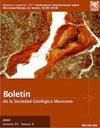Geologic observations in the San Marcos area, Coahuila, Mexico: the case for sediment-hosted stratiform copper–silver mineralization in the Sabinas basin during the Laramide orogeny
IF 0.4
4区 地球科学
Q4 GEOLOGY
引用次数: 2
Abstract
The sediment-hosted stratiform copper–silver mineralization in the San Marcos area of Coahuila, northeastern Mexico occurs predominantly at an Early Cretaceous redox boundary between footwall siliciclastic red beds of the San Marcos Formation and hanging-wall carbonate strata of the Cupido Formation in the Sabinas basin. The hypogene mineralization is mainly present as chalcocite-group minerals, with additional bornite and chalcopyrite, and everywhere occurs in both disseminated and vein/veinlet forms. Supergene copper-bearing oxides (malachite, chalcanthite, azurite, chrysocolla) are, however, the dominant surface expression of the mineralization. Additional sediment-hosted stratiform copper–silver mineralization also occurs, albeit erratically, in lower strata of the Sabinas basin as well as in veins in basement granitoids, thus spanning ~3000 m of basin stratigraphy. Where best developed, the stratiform mineralization displays intense structural control proximal to the regional San Marcos fault system. This major bounding fault, regional in nature and with numerous periods of activity, controlled the evolution of the Sabinas basin. Structural controls on mineralization include stacked, shallow-angle, bedding-parallel, northeast-vergent thrust faults and associated drag folds, in addition to numerous, steeply-dipping, northeast-trending copper-bearing veins and veinlets. The mineralized veins and veinlets, and the bedding-parallel thrusts display mutually crosscutting relationships. These elements are all consistent and in harmony with a regional northeast-trending direction of horizontal shortening accompanying reverse motion of the San Marcos fault system. Inversion along the San Marcos fault system, and the entire Sabinas basin in the Paleogene from ~60 to 40 Ma, resulted from wholesale contractional deformation during the Laramide (Mexican) orogeny. Hence, emplacement of the sediment-hosted stratiform copper–silver mineralization at San Marcos, and elsewhere in the larger Coahuila region, is interpreted as a natural corollary of large-scale, metal-bearing fluid expulsion, migration, and precipitation resulting from orogenic shortening, lithostatic loading, and squeezing of the Sabinas basin during Mexican orogen construction. Although sedimentation of the host strata in the Sabinas basin took place in a pericratonic setting associated with the opening of the Gulf of Mexico, sediment-hosted stratiform copper-silver mineralization occurred during orogenic uplift and conversion of the original basin into an orogen-foreland pair, with similarities to some of the world´s largest sediment-hosted stratiform copper provinces.墨西哥科阿韦拉圣马科斯地区的地质观测:Laramide造山运动期间Sabinas盆地沉积层状铜银成矿的案例
墨西哥东北部科阿韦拉的圣马科斯地区的沉积物层状铜-银矿化主要发生在萨宾纳斯盆地圣马科斯组下盘硅碎屑红层和Cupido组上盘碳酸盐层之间的早白垩世氧化还原边界。深生矿矿化主要以辉铜矿群矿物的形式存在,另有斑铜矿和黄铜矿,到处都以浸染状和脉/细脉的形式出现。浅生含铜氧化物(孔雀石、斑蝥石、天青石、温石棉)是矿化的主要表面表现形式。Sabinas盆地的较低地层以及基底花岗质岩石的矿脉中也出现了额外的沉积层状铜-银矿化,尽管不稳定,因此跨越了约3000 m的盆地地层。在最发达的地方,层状矿化在区域圣马科斯断层系统附近显示出强烈的结构控制。这条主要的边界断层具有区域性,具有许多活动期,控制着萨宾纳斯盆地的演化。对矿化的结构控制包括堆叠的浅角度、平行的层理、东北向边缘的逆冲断层和相关的拖曳褶皱,以及大量陡峭的东北向含铜矿脉和细脉。矿化脉、细脉与顺层平行逆冲断层呈相互横切关系。这些元素都是一致的,并与伴随圣马科斯断层系统反向运动的水平缩短的区域东北走向相协调。San Marcos断层系统和整个古近系Sabinas盆地在约60至40 Ma的反转,是Laramide(墨西哥)造山运动期间大规模收缩变形的结果。因此,San Marcos和更大的Coahuila地区其他地方沉积的层状铜-银矿化的侵位被解释为墨西哥造山带建造期间Sabinas盆地的造山缩短、岩石静载和挤压导致的大规模含金属流体排出、迁移和沉淀的自然结果。尽管Sabinas盆地中宿主地层的沉积发生在与墨西哥湾开口相关的克拉通纪周围环境中,但在造山隆升和原始盆地转化为造山-前陆对期间,发生了以沉积物为宿主的层状铜银矿化,与世界上一些最大的沉积层铜省相似。
本文章由计算机程序翻译,如有差异,请以英文原文为准。
求助全文
约1分钟内获得全文
求助全文
来源期刊
CiteScore
1.40
自引率
12.50%
发文量
34
审稿时长
50 weeks
期刊介绍:
The Boletín de la Sociedad Geológica Mexicana is a completely free-access electronic journal published semi-annually that publishes papers and technical notes with its main objective to contribute to an understanding of the geology of Mexico, of its neighbor areas, and of geologically similar areas anywhere on Earth’s crust. Geology has no boundaries so we may publish papers on any area of knowledge that is interesting to our readers.
We also favor the publication of papers on relatively unfamiliar subjects and objectives in mainstream journals, e.g., papers devoted to new methodologies or their improvement, and areas of knowledge that in the past had relatively little attention paid them in Mexican journals, such as urban geology, water management, environmental geology, and ore deposits, among others. Mexico is a land of volcanos, earthquakes, vast resources in minerals and petroleum, and a shortage of water. Consequently, these topics should certainly be of major interest to our readers, our Society, and society in general. Furthermore, the Boletín has been published since 1904; that makes it one of the oldest scientific journals currently active in Mexico and, most notably, its entire contents, from the first issue on, are available online.

 求助内容:
求助内容: 应助结果提醒方式:
应助结果提醒方式:


